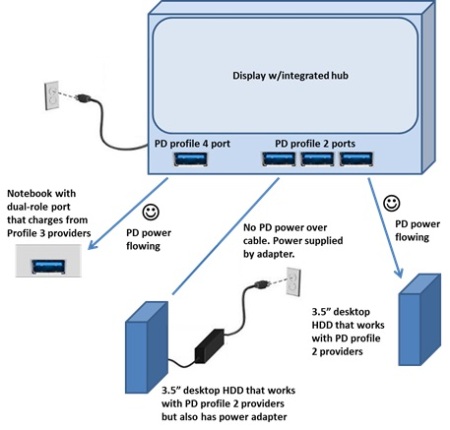
Ready for USB Power Delivery?
March 12, 2013The USB promoter groups released on July 2012 the new Power Delivery 1.0 specifications for USB3.0 and USB2.0. This new profile defines the mechanisms to deliver flexible and higher power over a standard USB data channel. USB Power Delivery (PD) devices can now delivery up to 100W and implement power management strategies across multiple peripherals by allowing each device to take only the power it requires, and to get more power when required for a given application.
Compatible with the actual mechanical (cables and plugs) and protocol ecosystem and in addition to the current BC1.2 specifications(USB Battery Charge v1.2), the new PD defines new cables and plug/sockets able to manage this higher power. The PD negotiation between devices is performed by a new specific communication protocol over the VBUS one-wire channel, without interfering with the USB data channel.
Compared with Thunderbolt, that is offering higher data speed performances, the USB PD specify a power delivery ten times what Thunderbolt can do. It means that you can charge up your laptop or power most any peripheral via Universal Serial Bus.
The natural implementation of this new PD profile is the wall plug charger that can now be used to deliver after negotiation enough power to supply and charge notebooks and portable devices. But any USB device with enough power capabilities, like a PD-enabled monitor, can be the USB power hub for multiple external devices like HDD/SDDs and notebook, as in picture below.
The new USB PD profile is a promising effort to unify and standardize the common needs of power delivery and to simplify the number and typologies of power cables we are now managing to charge and supply our battery operated devices.


[…] emerging USB Power delivery standard opens new and exciting scenarios in the consumer market. It will change the way we are dealing […]
[…] my blog, I already posted a lot about USB Power Delivery. This is for sure the solution offering the highest level of standardization, flexibility and […]
[…] spoke a lot about this technology in previous posts. The initial specifications have been released on 2012 and permit to deliver up to 100W over USB […]
[…] spoke a lot about this technology in previous posts. The initial specifications have been released on 2012 and permit to deliver up to 100W over USB […]
[…] interest was obviously for the USB Power Delivery and my target was to establish new contacts with the USB-PD players and to collect information of […]